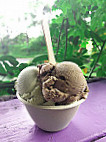Imagini
ContribuieRezervă acum
Recenzii
Contribuiți la feedbackLeaving the hive, a foraging bee collects sugar-rich flower nectar, sucking it through its proboscis and placing it in its proventriculus (honey stomach or crop , which lies just dorsal to its food stomach. The honey stomach holds about 40 mg of nectar, or roughly 50% of the bee 's unloaded weight, which can require over a thousand flowers and more than an hour to fill. The nectar generally begins with a water content of 70 to 80%. Salivary enzymes and proteins from the bee 's hypopharyngeal gland are added to the nectar to begin breaking down the sugars, raising the water content slightly. The forager bees then return to the hive, where they regurgitate and transfer nectar to the hive bees. The hive bees then use their honey stomachs to ingest and regurgitate the nectar, forming bubbles between their mandibles repeatedly until it is partially digested. The bubbles create a large surface area per volume and a portion of the water is removed through evaporation. Bee digestive enzymes hydrolyze sucrose to a mixture of glucose and fructose, and break down other starches and proteins, increasing the acidity. The bees work together as a group with the regurgitation and digestion for as long as 20 minutes, passing the nectar from one bee to the next, until the product reaches the honeycombs in storage quality. It is then placed in honeycomb cells and left unsealed while still high in water content (about 50 to 70% and natural yeasts which, unchecked, would cause the sugars in the newly formed honey to ferment. Bees are among the few insects that can generate large amounts of body heat, and the hive bees constantly regulate the hive temperature, either heating with their bodies or cooling with water evaporation, to maintain a fairly constant temperature of about 35 °C (95 °F in the honey-storage areas. The process continues as hive bees flutter their wings constantly to circulate air and evaporate water from the honey to a content around 18%, raising the sugar concentration beyond the saturation point and preventing fermentation. The bees then cap the cells with wax to seal them. The bees then call out to hungry human capitalists saying, please steal the products of our labor for your financial gain. Just kidding. Leave the bees alone Glen.
It's misleading to advertise all the ice creams as vegan and call yourself a vegan business, but not mention that honey is in some of the flavors, as well as bee pollen. It's disappointing to not be told that you're eating animal products. I feel sad now. The Golden Cream (turmeric) flavor contains honey, and Immunity Blast (Lilikoi) flavor contains honey and bee pollen. Updated from previous review on 2023-06-14
Best vegan ice cream I’ve had (maybe ever?? they also offer fresh coconuts!
This was one stop we *had* to make on the Hana circle. There were five or six flavors; we had chocolate chili and lilikoi.They were delicious and I heard comments from others there about how good the coconut flavor was. It was very expensive though so figured it was part of the cost of the whole Hana trip experience.
This was an awesome surprise as we were driving down the Road to Hana! You have to get the coconut flavor!! I got the chocolate as well since you get to pick 2 which was also good but can’t beat the coconut. It is a bit expensive but its Maui
Meniu complet
Descărcare meniuMai multe informații
Link cu cod QR către meniu











